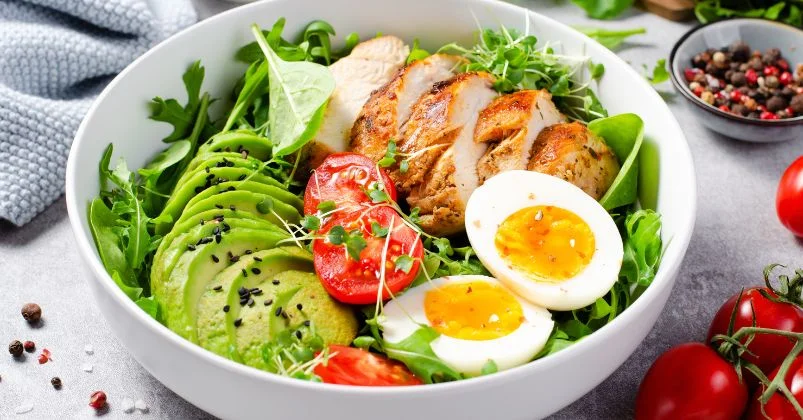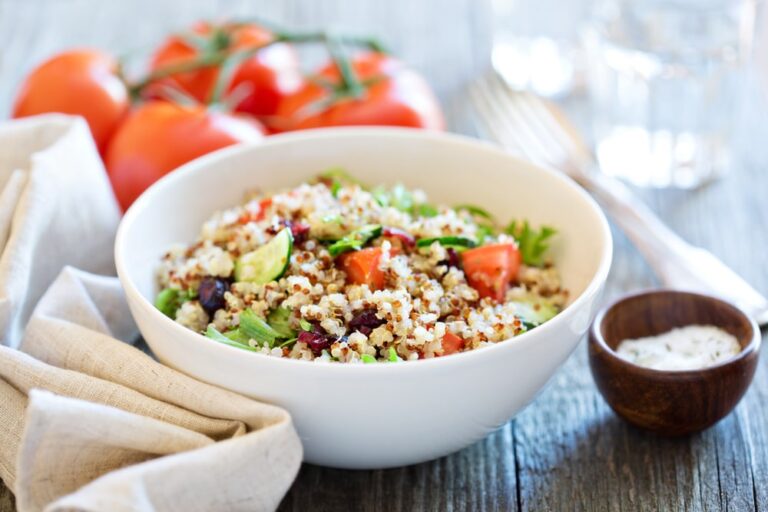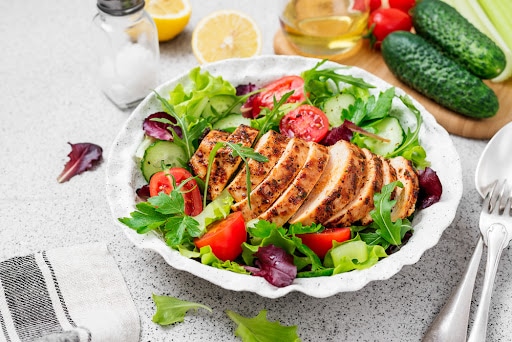What You Need to Know Before Breaking a Fast on Semaglutide
When it comes to weight loss, few strategies are as promising as combining intermittent fasting with semaglutide. But as effective as this combination can be, knowing how to break your fast properly is essential for maximizing results and supporting your overall health.
Hi there, I’m so glad you’re here. If you’re navigating your weight loss journey with semaglutide, you’re already taking a proactive step toward a healthier, more vibrant life. But let’s face it there's so much information out there that it can feel overwhelming at times. That’s why I’m here to simplify things for you.
In this guide, we’ll explore how to break your fast safely and effectively while using semaglutide. We’ll cover what foods to prioritize, what to avoid, and how to listen to your body during this transformative process. My goal is to equip you with practical, easy-to-follow tips so you can feel confident and supported every step of the way.
Let’s dive in together and make sure you’re set up for success!
Foods to Break Your Fast Safely

Breaking your fast is more than just the first meal after hours of no eating—it’s a crucial moment to nourish your body and set the tone for the rest of your day. If you’re using semaglutide to support your weight loss journey, choosing the right foods becomes even more important to maximize its benefits while protecting your health. Let’s look at the best foods to break your fast safely, with your well-being and goals in mind.
1. Start Gentle: Hydration is Key
After fasting, your body craves hydration as much as nutrition. Begin with a glass of water, herbal tea, or warm bone broth. These options are gentle on your stomach and prepare your digestive system for food. Bone broth, in particular, is rich in collagen and electrolytes, offering a nourishing start.
2. Prioritize Protein
Protein is essential for muscle repair, satiety, and maintaining steady blood sugar levels. Opt for easily digestible sources like:
- Eggs (boiled, scrambled, or poached)
- Greek yogurt (unsweetened or lightly sweetened with natural fruits)
- Lean meats like chicken or turkey slices
- Plant-based options like tofu or lentils
Protein not only curbs hunger but also complements the appetite-regulating effects of semaglutide.
3. Add Healthy Fats
Healthy fats help sustain energy and make your meal more satisfying. Incorporate small portions of:
- Avocado
- Nuts (almonds, walnuts, or pistachios)
- Seeds (chia, flax, or sunflower seeds)
- Olive oil or ghee
Be mindful of portion sizes since fats are calorie-dense, even the healthy ones!
4. Include Fiber-Rich Foods
Fiber helps ease your digestive system back into action while keeping you full for longer. Great options include:
- Steamed vegetables like spinach, zucchini, or asparagus
- A small piece of fruit, such as berries, an apple, or a pear
- Whole grains like quinoa or oats (if your body tolerates grains well)
Fiber slows digestion, preventing sudden spikes in blood sugar—a critical factor when managing weight with semaglutide.
5. Avoid Sugary and Processed Foods
Your body is sensitive after fasting, so steer clear of foods high in sugar, refined carbs, or unhealthy fats. These include pastries, sugary cereals, fried foods, or overly processed snacks. These can cause a rapid blood sugar spike, leaving you feeling sluggish or hungrier later.
6. Eat Mindfully
It’s easy to overeat when you’ve been fasting, but semaglutide helps you tune in to your body’s hunger cues. Take small bites, chew slowly, and stop when you feel satisfied, not stuffed.
A Balanced Plate for Breaking Your Fast
Here’s a simple example of a well-rounded meal to break your fast safely:
- A couple of boiled eggs or a small piece of grilled chicken
- Half an avocado or a handful of almonds
- A side of steamed spinach or a small bowl of mixed greens with olive oil
- A glass of water or herbal tea
Breaking your fast is an opportunity to refuel your body and set a positive tone for the rest of your day. With semaglutide supporting your weight loss journey, these thoughtful food choices will help you stay on track and feel your best.
Remember, you’re not just fueling your body, you're taking another step toward a healthier, more vibrant version of yourself. Keep it simple, stay mindful, and trust the process. You’ve got this!
The Importance of Nutrient Timing with Semaglutide
When it comes to achieving your weight loss and health goals, it’s not just about what you eat but when you eat. Nutrient timing plays a crucial role in optimizing the effects of semaglutide, a powerful tool in regulating appetite and supporting weight loss. Let’s break this down in a way that’s practical, easy to understand, and tailored to your journey.
What is Nutrient Timing?
Nutrient timing is the practice of eating specific types of nutrients—proteins, fats, and carbohydrates—at strategic times during the day to enhance your metabolism, energy levels, and overall health. For those on semaglutide, this approach can amplify its benefits by working in harmony with the medication’s appetite-regulating effects.
Why Nutrient Timing Matters with Semaglutide
- Maximizing Satiety
Semaglutide slows digestion, keeping you fuller for longer. Timing your meals to align with your body’s natural hunger signals ensures you avoid overeating or undereating, which could impact your energy levels and weight loss progress. - Stabilizing Blood Sugar Levels
Eating at consistent intervals helps prevent spikes and crashes in blood sugar, a key factor for weight loss and overall health. Pairing semaglutide with steady, well-timed meals can reduce cravings and improve your body’s response to food. - Sustaining Energy Throughout the Day
Strategically timed meals and snacks provide your body with the fuel it needs to stay active and focused. This balance prevents fatigue and ensures you feel your best while staying on track with your goals.
Key Nutrient Timing Strategies
- Start Your Day with Protein
Breakfast sets the tone for your metabolism. Even if you’re not typically a morning eater, a protein-rich meal within a few hours of waking can:
- Kickstart muscle repair
- Keep you full until your next meal
- Balance your blood sugar
Try options like scrambled eggs, Greek yogurt, or a protein smoothie with leafy greens.
- Time Carbs Around Activity
If you’re exercising or have a physically demanding day, consume complex carbohydrates (like quinoa, oats, or sweet potatoes) before or after activity to fuel your body and aid recovery. Avoid simple carbs that can cause sugar spikes. - Space Out Your Meals
Aim for 3 well-balanced meals and 1–2 snacks daily, with 3–4 hours between each to allow for digestion. This aligns with semaglutide’s effects, ensuring you stay satisfied without grazing throughout the day. - Choose a Light Dinner
Since semaglutide can curb nighttime hunger, you may not feel as compelled to eat a large dinner. Focus on lighter, nutrient-dense options such as a small portion of lean protein, steamed vegetables, and healthy fats like avocado or olive oil. - Hydrate, Hydrate, Hydrate
Don’t forget the importance of water! Proper hydration throughout the day supports digestion and complements your nutrient-timing efforts. Start each meal with a glass of water to enhance satiety.
A Sample Day of Nutrient Timing with Semaglutide
- Morning (8:00 AM): Protein smoothie with unsweetened almond milk, spinach, frozen berries, and a scoop of protein powder.
- Mid-Morning Snack (11:00 AM): A handful of almonds or a boiled egg.
- Lunch (1:00 PM): Grilled chicken salad with mixed greens, olive oil, and a slice of whole-grain bread.
- Afternoon Snack (4:00 PM): Carrot sticks with hummus or a small piece of cheese.
- Dinner (7:00 PM): Grilled salmon, steamed broccoli, and a small serving of quinoa.
- Optional Evening Snack (9:00 PM): A cup of herbal tea or a small handful of walnuts.
Nutrient timing isn’t about perfection it’s about consistency and listening to your body. When paired with semaglutide, this mindful approach to eating can enhance your weight loss journey, boost your energy, and make you feel in control of your health.
Remember, you’re building habits that support a sustainable, healthier lifestyle. You’re doing amazing one meal, one choice, and one step at a time!
What to Avoid When Breaking a Fast on Semaglutide
Breaking a fast is a pivotal moment in your day, especially when you’re using semaglutide to support your weight loss journey. While it’s important to focus on nourishing foods, knowing what to avoid can help you protect your progress, maintain steady energy, and feel your best. Here’s a straightforward guide to steer clear of common pitfalls and set yourself up for success.
1. Avoid Sugary and Processed Foods
After fasting, your body is sensitive to rapid changes in blood sugar. Foods high in sugar and refined carbs, like pastries, candy, or sugary drinks, can cause a sudden spike followed by a crash, leaving you feeling tired and hungrier later.
- Why It Matters: Semaglutide works to regulate appetite and blood sugar. Introducing high-sugar foods undermines these benefits and can make it harder to stick to your goals.
- Better Choice: Opt for complex carbohydrates like whole grains or fiber-rich fruits such as berries.
2. Steer Clear of High-Fat, Fried Foods
While healthy fats are important, greasy, fried foods like chips, fried chicken, or fast-food burgers are tough on your digestive system after fasting. These foods can lead to bloating, discomfort, and even nausea when combined with semaglutide’s effects.
- Why It Matters: Semaglutide slows digestion, so adding heavy, oily foods can make you feel sluggish or overly full.
- Better Choice: Choose healthy fats in moderation, such as avocado, nuts, or olive oil.
3. Avoid Overeating
It’s tempting to eat a large meal after fasting, but overeating can overwhelm your digestive system and make you uncomfortable. Semaglutide helps curb your appetite, so let it guide you by eating slowly and stopping when you feel satisfied.
- Why It Matters: Eating too much at once can negate the appetite-regulating effects of semaglutide and leave you feeling lethargic.
- Better Choice: Start with a small, balanced plate and allow your body to signal when it’s full.
4. Skip Carbonated or Sugary Beverages
While it might be tempting to reach for soda or other fizzy drinks, these can cause bloating and add unnecessary calories. Sugary drinks, in particular, spike your blood sugar and can lead to energy crashes.
- Why It Matters: Staying hydrated with the right beverages is key to supporting your body while using semaglutide. Sugary and carbonated drinks do more harm than good.
- Better Choice: Stick to water, herbal tea, or unsweetened beverages like infused water with lemon or cucumber.
5. Limit Spicy or Acidic Foods
Foods like hot peppers, citrus fruits, or vinegar-based dishes can be harsh on your stomach after a fast, especially when semaglutide is already slowing digestion.
- Why It Matters: Spicy and acidic foods can lead to indigestion or discomfort, making it harder to enjoy your meal.
- Better Choice: Go for mild, gentle options like steamed vegetables, lean proteins, and whole grains.
6. Avoid Processed Snack Foods
Packaged snacks like chips, crackers, or sugary granola bars may seem like a convenient way to break your fast, but they lack the nutrients your body needs and can lead to overeating.
- Why It Matters: These foods provide empty calories, which won’t keep you full or energized.
- Better Choice: Reach for whole foods like raw veggies, nuts, or a hard-boiled egg.
Breaking your fast is a time to nurture your body with foods that complement your semaglutide journey. By avoiding sugary, greasy, or overly processed options, you can support your digestion, maintain steady energy, and stay aligned with your goals.
Remember, small, mindful choices add up to big results. Be kind to your body, listen to its needs, and trust the process you’re doing is amazing!
FAQs
Start with hydration, followed by protein, healthy fats, and fiber-rich foods. Avoid sugary, processed, and fried foods to maintain steady energy and support weight loss.
Yes, but opt for complex carbs like whole grains, quinoa, or oats. These provide steady energy and prevent blood sugar spikes.
Sugary foods cause rapid blood sugar spikes and crashes, which can interfere with semaglutide’s appetite-regulating effects and may make you feel sluggish or hungrier later.
Eating at consistent intervals, with protein-rich meals and healthy snacks, maximizes semaglutide’s benefits by stabilizing blood sugar levels and promoting satiety.
Steer clear of sugary foods, fried foods, overeating, carbonated drinks, and processed snacks. These can disrupt digestion and hinder weight loss progress.








